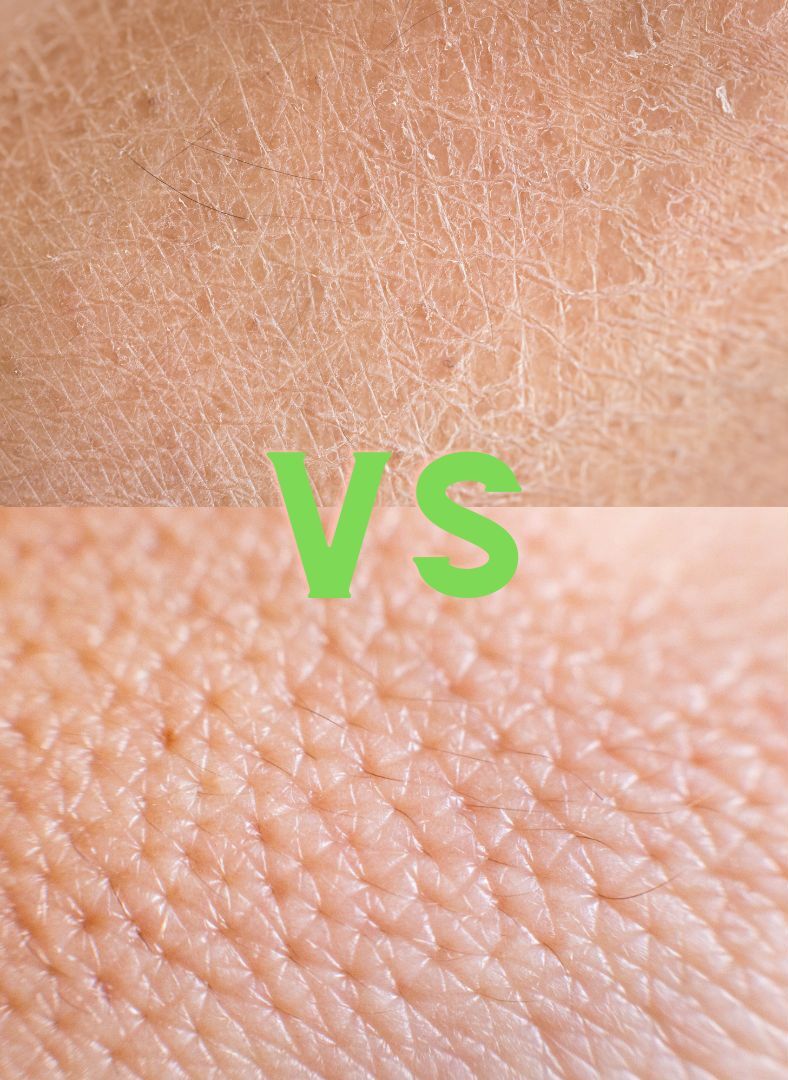

The distinctions between different skin types are not always as straightforward as they appear. Oily versus dry seems rather self-explanatory. You see oil on your skin, so you must have oily skin, right? Not always, since oil production can be a bit more complex. To help us sort through some of the finer points, we’re digging in deeper to decipher dry skin vs oily skin.
Oily Skin vs. Dry Skin
First, let’s do a little refresher on the basics. Dry skin produces little to no oil, which causes the skin to be dry and flaky. Oily skin is skin that produces oil, and generally it will have large pores and look shiny or greasy. That much probably makes plenty of sense to you, but the dehydrated skin distinction gets a little trickier.
Dry Skin Characteristics
If your skin is usually tight after you wash it, or even when you're in the shower without having washed it yet, this means that your skin is probably dry.
Here are some other signs to look for:
- Flakes or scaly patches appearing on the face
- If you have to apply body lotion at least once a day, your skin may be too dry
- If your skin feels really rough and bumpy when you pat it with your hands, then it's probably severely dry
- Oftentimes the area around the nose tends to be crinkly if your skin is dry
- The pores on our skin can get clogged easily when there isn't enough moisture in the skin itself. This causes blackheads to appear
- If you're dealing with extremely dry skin, look for symptoms like redness, peeling, and scaling
- If your skin is dehydrated, it will also be flaky and show signs of cracking or scaling
You may not see any of these symptoms when you first wake up in the morning; this is because your body naturally restores moisture to the surface of the skin at night. The moment you wash your face, however, all of those symptoms will surface. The skin's natural hydration level is restored as soon as its exposed to the elements again.
Oily Skin Traits
This one can be a little trickier. Oily skin does not necessarily equate to acne; in fact, many people who have an oilier complexion never suffer from outbreaks.
However, how do you know how to tell if your skin is oily?
Characteristics of oily skin include:
- If your T-zone (forehead and down the nose) gets shiny, this could mean that your skin is producing more sebum than average
- You may notice slight pimples or blemishes on the forehead or chin
- You're probably wearing a lot of powder or foundation because your skin looks very shiny
- You have to use blotting sheets regularly
- Oily skin typically has large pores
While both oily and dry skin types are susceptible to breakouts, how it manifests can be very different. Oily skin tends to result in large blemishes or pimples, whereas dry skin often manifests as tiny whiteheads
Dehydrated Skin
Dehydrated skin isn’t necessarily overly dry skin. Dehydrated skin is oily, combination, or normal skin that is lacking water and feels tight. It's a skin condition, not a skin type: Having tight skin doesn’t necessarily mean it’s dry. Dehydrated skin, as a skin condition, lacks water content, but may still produce oil. In fact, it may be over-producing oil to compensate for the lack of moisture in the skin. Dehydrated skin is common among those with oily and acne-prone skin who use harsh products that strip the skin of water. If this sounds familiar, keep reading for 4 main tips on how to get your skin back to a healthy state.
1. Cleanse Smarter
It all starts with cleansing. Try using sulfate-free cleansers to prevent unnecessary dehydration when washing. Try a fragrance free face wash and go easy on exfoliation. Using a lot of acids and scrubs too often or too aggressively can cause surface dehydration and inflammation.
2. Never Go Bare
Never leave the skin bare for more than 60 seconds after washing. Immediately apply alcohol-free toner, serum, and moisturizer. When your skin is left bare, the air instantly starts sucking moisture right out of it. Move onto your non-drying skin care products right away.
3. Add a Serum
Add a serum under moisturizer for additional hydration. Just a few drops of a lightweight serum under an oil-free moisturizer provides an extra boost of moisture, without adding heavy layers of products.
4. Use Humectants
When shopping for skin care, look out for products with humectants like glycerin, hyaluronic acid, sodium PCA, sorbitol, allantoin, and propylene glycol. These are ingredients that help attract water from the environment into the skin to keep it soft and supple.
5. Give Natural Ingredients a Shot
When in doubt, avoid all of the main brands filled with preservatives, fillers, and heavy fragrances (no matter how good they smell, your skin doesn’t want that) and give natural skin care a try instead! You will be shocked at how your skin becomes transformed! Ingredients like manuka honey, coconut oil, carrot seed oil, and hemp seed oil are the perfect ingredients to help nourish dry skin and balance out oil production. (It’s a myth that oil-based products are bad for oily skin.)
So come take a peek at Wild Naturals where our natural skin care line offers every skin type magic benefits that result in happy, glowing skin!


